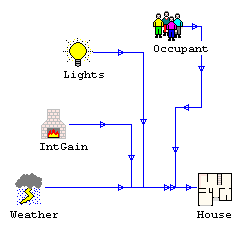



![]()
The loads that the ground source heat pump system must meet are dependent on several important factors; the weather, occupancy schedule, lighting schedule, infiltration, internal gains, and ventilation effects. Unlike most of the major simulation programs on the market today, TRNSYS does not decouple the loads from the HVAC system! The loads and the system response are solved simultaneously; providing a much more accurate solution.
![]() BUILDING MODEL:
BUILDING MODEL:
In TRNSYS there are several different building models that could have been chosen to perform the load calculations (detailed multi-zone building, detailed single-zone building model, degree-day building model, etc.) In this simulation, the building is modeled with a new lumped capacitance building model written by Thermal Energy System Specialists of Madison, WI. This new subroutine represents a simpler approach to building simulation than the standard TRNSYS models, but makes for extremely quick simulation times.
![]() WEATHER:
WEATHER:
The TRNSYS program has two unique methods of providing weather data to simulations. Weather data may be read from a data file (Typical Meteorological Year weather files are available for TRNSYS), or weather data may be generated based on monthly averages of solar radiation, ambient temperature, humidity ratio, and wind speed. This simulation utilizes the TRNSYS weather generator component. A file of monthly averages for 330 U.S. and Canadian cities is included with the program. In this simulation, the weather generator component allows the user to quickly choose from any of the 330 sites with a click of the mouse. The building model requires the ambient temperature (for skin losses and sensible infiltration gains/losses) and the ambient humidity ratio (for latent infiltration gains).
![]() INTERNAL LOADS:
INTERNAL LOADS:
The building model allows the user to specify the internal gains to the space. In this simulation, the internal gains will be varied throughout the day based on a pre-defined schedule. This schedule is input to the program by the use of the TRNSYS forcing function component.
![]() LIGHTING LOADS:
LIGHTING LOADS:
The building model allows the user to specify the lighting gains to the space. In this simulation, the lighting gains will be varied throughout the day based on a pre-defined schedule. This schedule is input to the program by the use of the TRNSYS forcing function component.
![]() OCCUPANCY GAINS:
OCCUPANCY GAINS:
The building model allows the user to specify the sensible and latent gains to the space. In this simulation, the occupancy will be varied throughout the day based on a pre-defined schedule. This schedule is input to the program by the use of the TRNSYS forcing function component.
![]() INFILTRATION:
INFILTRATION:
The infiltration gains/losses are calculated by
the simple ASHRAE approach to infiltration (K1,K2,K3 method).
These loads are then input to the building model. ![]()
![]()